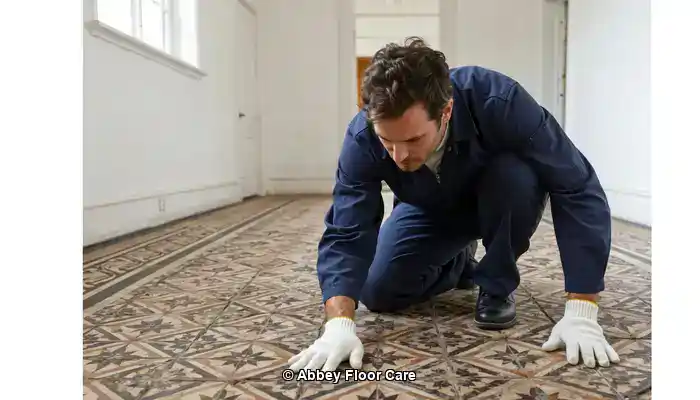
Last Updated on October 30, 2025 by David
Proven Techniques for Restoring Lost Colour and Pigment in Victorian Mosaic Tiles
- Victorian mosaic tiles often experience colour loss due to embedded dirt, outdated coatings, and surface erosion that extend beyond natural aging.
- Aggressive scrubbing and harsh chemicals can damage the original pigments in tiles, especially in encaustic and geometric patterns.
- Successful restoration starts with thorough deep cleaning using pH-neutral solutions and low-speed rotary machines equipped with soft brushes.
- To evaluate the condition of the tiles accurately, it is essential to carefully eliminate old sealers and waxes.
- Enhancing colour can be achieved through breathable, stone-safe sealers that enrich tone without producing a shiny finish.
- Expert restoration can revive original pigments without resorting to repainting or artificial techniques, ensuring historical authenticity.
- Maintaining restored tiles requires gentle cleaning methods and avoiding acidic or bleach-based products.
- Heritage-sensitive approaches protect both the aesthetic charm and historical significance of the tiles.
Diving Deep into the Art of Restoring Victorian Tiles to Their Former Glory
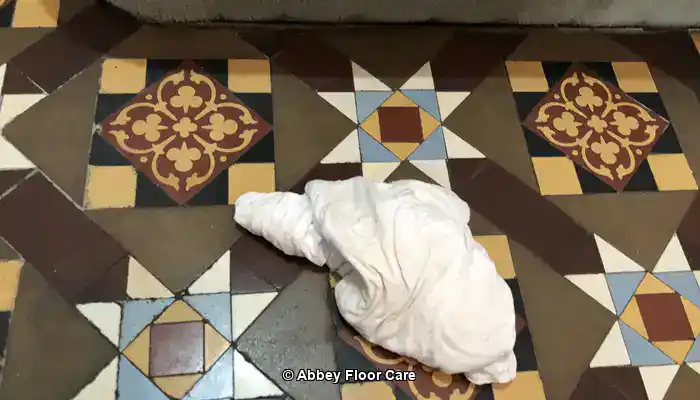
Victorian encaustic and mosaic tiles play a vital role in British architectural heritage, celebrated for their intricate artistry and unique colour schemes sourced from mineral pigments within the clay. However, these stunning tiles can lose their vibrancy over time due to factors such as environmental exposure, chemical reactions, and general wear. Successfully restoring their original brilliance requires a specialized skill set that blends material knowledge with historically accurate methods essential for rejuvenating these remarkable surfaces.
Pro Tip: Recommended Daily Care Products for Victorian Tiles
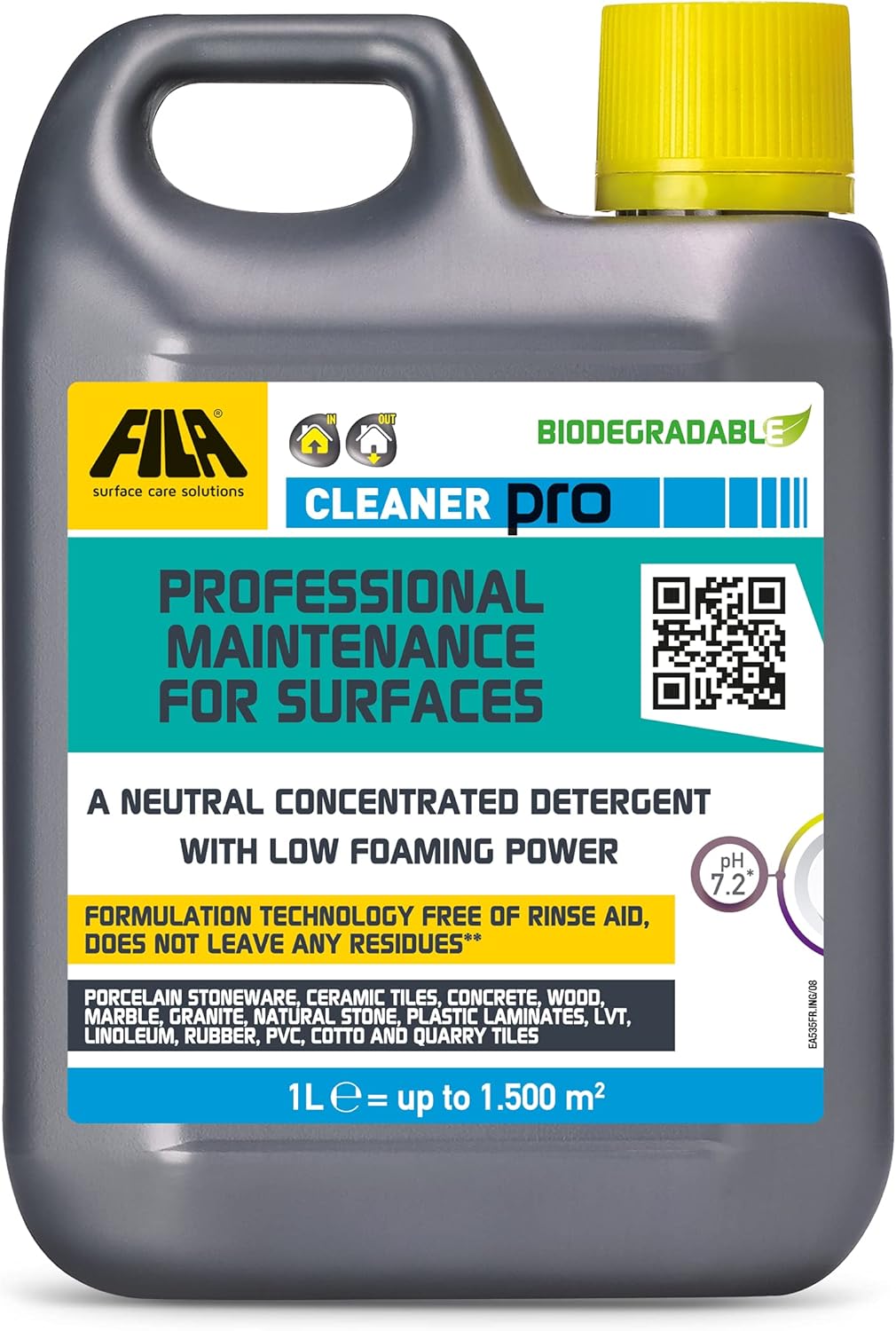
Fila Pro Floor Cleaner
|

LTP Colour Intensifier & Stainblock H20
|
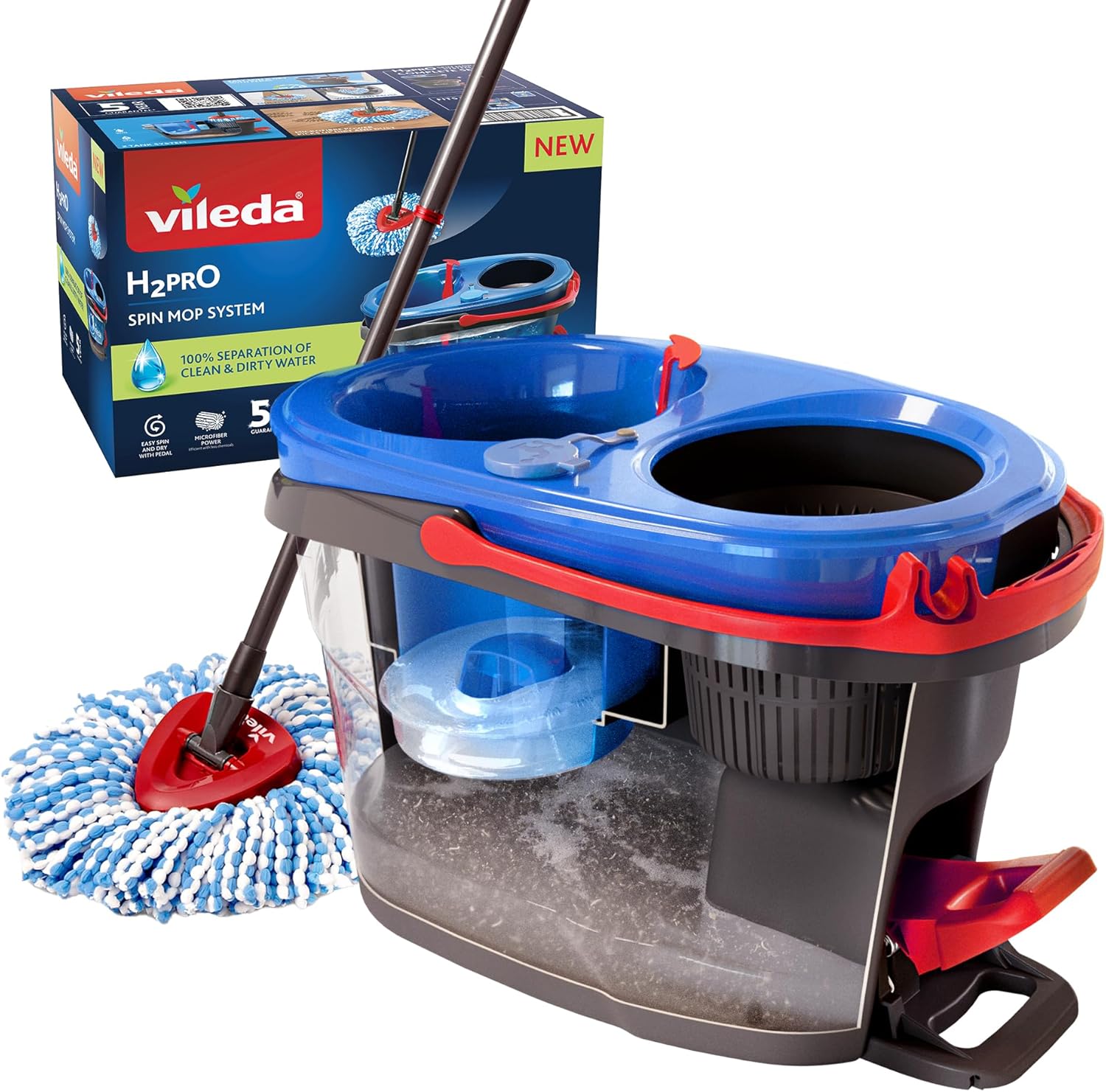
Vileda H2PrO Spin Mop System
|
Over time, these stunning tiles often diminish visually due to surface wear, chemical reactions, and environmental factors. The process of restoring their original vibrancy is a skilled task that demands a comprehensive understanding of the materials, historically appropriate techniques, and high-quality products specifically designed for this delicate work.
Understanding the Factors Behind the Fading and Dulling of Victorian Mosaic Tiles
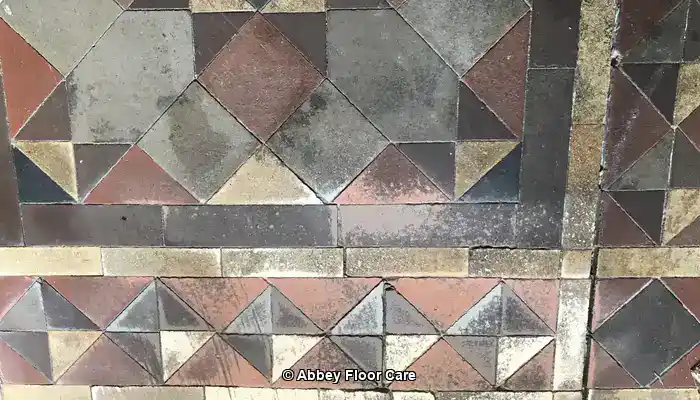
Example of Victorian Clay Tile Floor dulled through surface wear and damage.
The fading and dulling of the pigments integral to the tiles can stem from several contributing factors:
- Accumulated dirt and grime: Over time, high foot traffic introduces fine particles and oils that penetrate porous surfaces, scattering light and dulling the vibrant colours.
- Wax and polish buildup: Layers of wax or sealants that lack breathability can trap moisture, leading to a cloudy or yellowed appearance that detracts from the visual appeal of the tiles.
- Moisture-related issues: Many Victorian tiles were installed over subfloors that do not have damp-proof membranes, resulting in rising damp that carries soluble salts, which crystallize on the tile surface as efflorescence, further obscuring the original hues.
- Physical abrasion: Years of use create tiny surface scratches that disrupt smooth light reflection, reducing the visual richness of the tiles.
Effective restoration must carefully address each of these issues without compromising the tiles’ historic integrity, ensuring that the beauty and character of the tiles are preserved for future generations to cherish.
The Importance of Breathability in Absent Damp-Proof Membranes
Since many Victorian tiled floors are laid on older subfloors that lack a damp-proof membrane (DPM), the natural clay structure must remain permeable to allow moisture to evaporate from the subfloor. Non-breathable wax coatings or film-forming sealers obstruct this essential evaporation process, leading to moisture buildup beneath the surface. This accumulation traps salts and humidity, which can cause efflorescence and surface mineral degradation, along with an undesirable condition known as wax blooming—a white haze appearing on the tile. Consequently, restoration strategies must prioritize breathable impregnating sealers that protect the tiles while allowing moisture vapor to escape, thereby preventing long-term damage.
Exploring the Composition of Pigments in Victorian Tiles
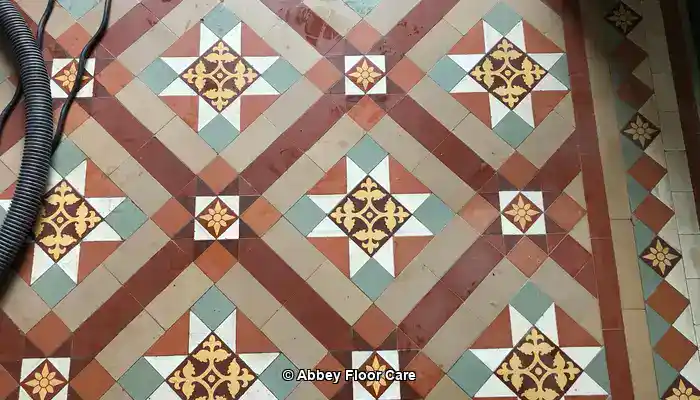
An example of different pigments in a Victorian Clay tile floor during restoration by Abbey Floor Care
Examining the Role of Mineral Oxide Pigments in Victorian Tiles
Victorian mosaic and encaustic tiles derive their unique earthy colours from mineral oxide pigments that are embedded directly within the clay body. These pigments not only enhance aesthetic appeal but also provide durability and colour depth. The primary pigments include:
- Iron oxide: generates terracotta reds, rust browns, and soft ochres.
- Manganese: produces deep browns and rich blacks.
- Cobalt: imparts various blue tones.
- Chromium: creates natural green hues.
How the Firing Process Ensures Long-lasting Colour Integrity
During manufacturing, the tiles are fired at temperatures around 1100°C, a process that vitrifies the clay and fuses the pigments deep into the tile structure. This method guarantees that the colour permeates throughout the tile rather than merely resting on the surface, providing enduring vibrancy that resists fading over time.
Identifying the Characteristics of a Porous Unglazed Finish
Victorian tiles typically showcase a porous, unglazed matte finish, offering a natural look that many find appealing. However, this porosity also makes the tiles absorbent and sensitive to surface contamination and moisture, necessitating careful cleaning and maintenance practices to maintain their integrity and appearance.
Understanding Colour Durability Variability Based on Tile Composition
Natural earth pigments, especially in red and yellow tiles, contain fewer mineral additives than darker hues like black, which are formulated with manganese. This disparity means that red and yellow tiles tend to be less durable and more susceptible to surface wear under heavy foot traffic. This wear often manifests as shallow depressions in high-traffic areas, resulting in uneven colour intensity and a loss of surface flatness.
Essential Considerations for Effective Restoration
A thorough understanding of pigment composition and tile wear patterns is vital for planning successful restoration efforts. Softer-toned tiles require gentler cleaning methods and specially formulated impregnating sealers that respect their unique properties while enhancing colour. Conversely, darker, harder tiles can withstand more rigorous cleaning but still need breathable, colour-enhancing protection to maintain their vibrancy over time and prevent degradation.
Effective Cleaning Techniques to Restore Victorian Mosaic Tiles
Proper cleaning is crucial for bringing Victorian encaustic and mosaic tiles back to their original vibrancy. However, the cleaning protocols for these tiles necessitate a specialized approach that goes beyond just using standard pH-neutral detergents. Professional restorers employ carefully formulated alkaline cleaners and mechanical techniques to efficiently remove heavy soiling and old residues without compromising the historic integrity of the tiles.
Initial Debris Removal: A Fundamental Step in Effective Cleaning
The cleaning process commences with the thorough removal of all loose dirt and grit using soft brushes or vacuuming with brush attachments. This critical first step is essential to prevent scratching the delicate tile surfaces during the subsequent cleaning phases, ensuring that the restoration process is both effective and safe for the tiles.
How Alkaline Cleaners Facilitate Intensive Soil Removal
Unlike pH-neutral cleaners, which may lack the chemical strength to combat ingrained fatty acids and organic soils, alkaline cleaners are essential for breaking down household oils, grease, and sticky residues commonly found on tile surfaces and in grout lines. These alkaline formulations dissolve the binding agents found in dirt, sugars, and fats, allowing for effective removal while maintaining compatibility with the mineral composition of Victorian tiles.
Professional-grade alkaline products, such as PS87 PRO or custom formulations from heritage cleaning specialists, are typically used in diluted forms. This method ensures deep cleaning without being overly aggressive on the clay body. It is crucial to remember that caution is necessary even with alkaline cleaners, and spot testing is always recommended to avoid any unintended damage.
Utilizing Mechanical Agitation to Optimize the Cleaning Process
Mechanical action significantly enhances the effectiveness of the cleaning process. Low-speed rotary scrubbers equipped with red or, in some cases, green non-abrasive pads are routinely employed to agitate soils from small pits, tile surfaces, and grout lines. These pads clean thoroughly while preserving the integrity of tile edges and delicate surface details, ensuring that the restoration maintains the original beauty of the tiles.
Removing Old Waxes and Sealants to Preserve Tile Integrity
Years of use often result in the buildup of old waxes and sealants, especially from DIY attempts using inappropriate products. Water-based cleaners—either alkaline or mildly acidic—are preferred for removing these residues without damaging the tile’s mineral structure. However, stubborn ‘exotic’ or solvent-resistant coatings require targeted solvent-based removers such as Lithofin Wax-Off or LTP Solvex. These solvents effectively soften and emulsify waxes and old sealants but must be handled with care by professionals trained in their safe application and disposal.
Thorough Rinsing and Drying: Crucial Final Steps in the Cleaning Process
After chemical cleaning, comprehensive rinsing is essential to eliminate all cleaning residues. Multiple rinses with clean water, combined with wet vacuum extraction, ensure that no detergent or solvent remnants remain to interfere with subsequent restoration coatings. Drying time varies based on environmental conditions, such as humidity, surface type, and moisture levels. Restoration specialists consistently utilize moisture meters to verify that tiles are completely dry before applying any impregnating sealers or protective treatments. This meticulous approach prevents moisture entrapment, which could lead to efflorescence, staining, or damage beneath sealed layers.
The Benefits of Extensive Cleaning: Revealing the True Condition of the Tiles
Thorough cleaning uncovers the actual condition of the tiles by removing visual obstructions. It highlights areas that may need repair and provides a clean, receptive surface for colour-enhancing impregnators or other restorative products. This careful preparation is fundamental to the success and longevity of Victorian mosaic tile restoration, ensuring that the final outcome meets both aesthetic and functional standards.
Enhancing Colour with High-Quality Impregnating Sealers
Restorers utilize impregnating colour-enhancing sealers from LTP and Lithofin, brands recognized for their advanced, heritage-approved formulations. Unlike superficial coatings, these sealers:
- Deeply penetrate tile pores to physically enrich colour by changing light refraction.
- Maintain vapour permeability, which is critical for moisture escape, particularly in older floors lacking DPM layers.
- Provide durable protection against stains and foot traffic without altering the natural texture or gloss.
- Are applied in multiple light coats, allowing each layer to penetrate before the next is applied to ensure complete uniformity.
These sealers effectively combat fading by restoring vibrancy while preserving the historic floor’s breathable nature, ensuring a harmonious balance between protection and aesthetics.
Repairing Chips and Cracks in Victorian Tiles: Techniques for Seamless Restoration
Tiles exhibiting chips, cracks, or missing pieces necessitate careful repair using tinted epoxy or lime-based mortars, which are colour-matched with natural mineral oxides to integrate seamlessly with the original tiles. Restoration experts often source matching replacement tiles from salvage archives to maintain pattern continuity. Colour tinting entails selectively applying earth-pigment-infused wax or resin mixtures to blend in worn or missing pattern sections sensitively, while respecting tile breathability and reversibility to uphold the integrity of the restoration.
Best Practices for Colour Tinting: Achieving Flawless Integration
- Apply small, controlled amounts to avoid excessive colouring and ensure a natural finish.
- Conduct patch testing on inconspicuous areas prior to full application to confirm compatibility and colour accuracy.
- Ensure compatibility with the impregnating sealers used throughout the entire surface to maintain a consistent appearance.
Ensuring Longevity of Restored Victorian Mosaic Floors Through Proper Maintenance
To maintain the restored colour and condition of Victorian mosaic tiles, ongoing care and attention are vital:
- Regular cleaning with pH-neutral, non-abrasive detergents specifically designed for historic tiles is essential to avoid harming the surface.
- Implement preventive measures, such as placing entrance mats strategically to reduce dirt ingress and safeguard the tile surfaces.
- Promptly address liquid spills, especially acidic substances like vinegar or wine, to prevent surface etching and damage.
- Regularly reapply breathable impregnating sealers every 3-5 years or as needed to sustain protection and vibrancy.
- Monitor the floors for signs of efflorescence or moisture ingress, which may indicate underlying damp issues that require further investigation.
Avoiding Common Mistakes in Restoration Projects: Key Insights
- Avoid using wax treatments that can obstruct breathability, cause efflorescence, or lead to wax blooming, which diminishes the tile’s appearance.
- Do not apply acrylic or polyurethane sealants that can trap moisture and cause degradation of the tiles over time.
- Limit the use of harsh chemical cleaners, as they can erode clay and pigments, resulting in irreversible damage.
- Never repaint tiles; paint films alter their visual and physical properties and are not reversible, potentially ruining the original tiles.
- Identify and address issues in older subfloors before sealing to ensure lasting results.
Highlighting Successful Restoration Projects: Real-World Case Studies
Various examples illustrate the successful application of these restoration principles:
A Victorian Hallway Restoration Project in Sheffield
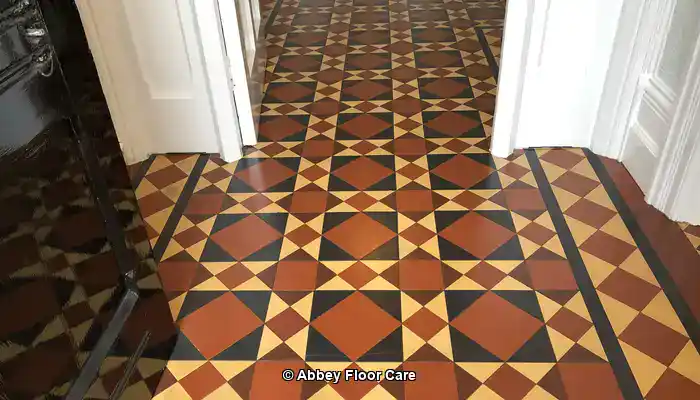
Our cleaning process effectively removed years of wax and grime, followed by the application of a Lantania Avo colour-enhancing impregnating sealer, which visibly deepened the colours of the tiles. This was subsequently protected with an acrylic topical sealer to provide surface protection for floors laid over a damp-proof membrane, ensuring both durability and visual appeal.
A Restored Civic Mosaic Floor in Chesterfield
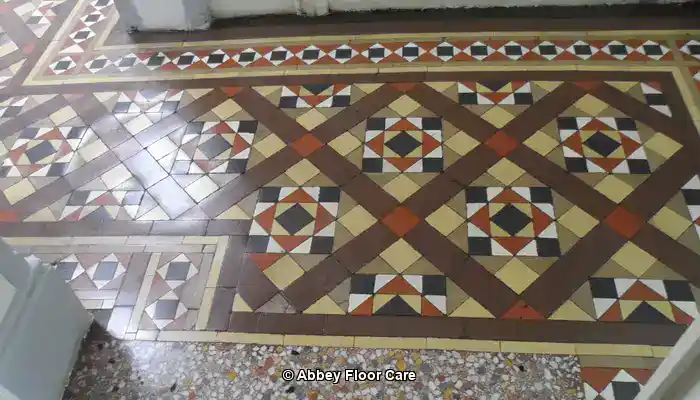
After thorough cleaning and removal of old topical sealers, the floor was sealed with an LTP Colour Enhancing Impregnating sealer. The surface was further protected with wax, which was meticulously applied to seamlessly integrate the clay tiles into the historic fabric of the building, preserving both functionality and aesthetics.
Expert Insights on Preserving Heritage Through Thoughtful Restoration
Restoring the colour and pigment of Victorian mosaic tiles is a complex endeavor that balances material science, craftsmanship, and heritage sensitivity. By utilizing top-quality impregnating colour-enhancing sealers from industry leaders like Dry Treat, Lantania, and Lithofin, restorers can ensure lasting breathability, protection, and vibrancy of colours. Skilled cleaning, careful repairs, and dedicated maintenance not only uphold authenticity but also revive these historic floors for future generations to appreciate and enjoy.
Frequently Asked Questions About Victorian Mosaic Tile Restoration
What are Victorian mosaic tiles?
Victorian mosaic tiles are decorative tiles that became popular during the 19th century, renowned for their vibrant colours and intricate patterns. They were extensively used in both public buildings and private residences, significantly contributing to the unique architectural landscape of that period.
How can I effectively restore faded Victorian mosaic tiles?
Restoring faded Victorian mosaic tiles involves a comprehensive multi-step process that includes thorough cleaning, repairing any damages, applying new pigments to match the original colours, and finally sealing the tiles to protect them from further deterioration.
What materials are essential for effective tile restoration?
Essential materials for tile restoration include specialized cleaning solutions, pigments for colour matching, adhesives, grout, and protective sealants, all carefully chosen for compatibility with the original tiles.
How long does the restoration process for tiles typically take?
The duration of tile restoration can vary significantly depending on the size and condition of the area being restored, typically ranging from a few days for smaller projects to several weeks for more extensive restorations, based on the complexity of the work involved.
Can I undertake the restoration myself?
Yes, smaller restoration projects can often be addressed as DIY tasks if you possess the necessary skills and tools. However, more complex repairs generally require professional expertise to ensure quality results and prevent potential damage to the tiles.
What is the expected cost associated with restoring Victorian mosaic tiles?
The costs for restoration can vary greatly based on project size and condition, ranging from a few hundred to several thousand pounds for comprehensive restorations, depending on the extent of the work required.
How do I choose the right restoration expert for my project?
When selecting restoration professionals, look for those with experience in historical projects, positive reviews, and a commitment to using authentic materials and techniques that align with the heritage of your tiles.
What challenges do restorers commonly face during the process?
Restorers frequently encounter challenges such as accurately matching original colours, repairing damaged tiles without compromising the overall design, and ensuring the longevity of the restoration work to prevent future issues.
How can I maintain my restored tiles effectively?
Regular maintenance involves cleaning with pH-neutral products, avoiding harsh chemicals, resealing periodically, and promptly addressing any damage to ensure the longevity and appearance of the restored tiles.
What innovations are currently shaping the future of tile restoration?
Recent innovations in tile restoration include advanced cleaning solutions, new types of sealants that enhance durability, and digital technology for precise colour matching and pattern replication, all contributing to improved quality in restoration outcomes.
The Article Restoring Colour and Pigment to Faded Victorian Mosaic Tiles first found on https://www.abbeyfloorcare.co.uk
The Article Restoring Faded Victorian Mosaic Tiles with Colour and Pigment appeared first on https://fabritec.org
The Article Restoring Victorian Mosaic Tiles with Vibrant Color and Pigment Was Found On https://limitsofstrategy.com

